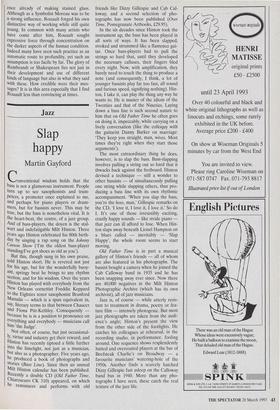Jazz
Slap happy
Martin Gayford
Conventional wisdom holds that the bass is not a glamorous instrument. People turn up to see saxophonists and trum- peters, a promoter once explained to me, and perhaps for piano players or drum- mers, but for bassists never. This may be true, but the bass is nonetheless vital. It is the heart-beat, the centre, of a jazz group. And of bass-players, the doyen is the stal- wart and indefatigable Milt Hinton. Three Years ago Hinton celebrated his 80th birth- day by singing a rap song on the Johnny Carson Show (I'm the oldest bass-player standing/I've got shoes as old as you').
But this, though sung in his own praise, sold Hinton short. He is revered not just for his age, but for the wonderfully buoy- ant, springy beat he brings to any rhythm section, and for his wisdom. Over the years Hinton has played with everybody from the New Orleans cornettist Freddie Keppard to the Eighties tenor saxophonist Branford Marsalis — which is a span equivalent in, say, literary terms to that between Chaucer and Fiona Pitt-Kethley. Consequently because he is in a position to pronounce on everything and everybody — musicians call him 'the Judge'.
Not often, of course, but just occasional- 1Y, virtue and industry get their reward; and Hinton has recently tiptoed a little further into the limelight, not just as a musician, but also as a photographer. Five years ago, he produced a book of photographs and stories (Bass Line). Since then an annual Milt Hinton calendar has been published. Recently a double CD (Old Father Time, Chiaroscuro CK 310) appeared, on which he reminisces and performs with old
friends like Dizzy Gillespie and Cab Cal- loway; and a second selection of pho- tographs has now been published (Over Time, Pomegranate Artbooks, £29.95).
In the six decades since Hinton took the instrument up, the bass has been played in all sorts of ways. It has been slapped, stroked and strummed like a flamenco gui- tar. Once bass-players had to pull the strings so hard that, until they developed the necessary calluses, their fingers bled every night. Now, with amplification, they barely need to touch the thing to produce a note (and consequently, I think, a lot of younger bassists play far too fast, all sound and furious speed, signifying nothing). Hin- ton, I take it, can play the thing any way he wants to. He is master of the idiom of the Twenties and that of the Nineties. Laying down a bass line is such second nature to him that on Old Father Time he often goes on doing it, impeccably, while carrying on a lively conversation (like the colloquy with the guitarist Danny Barker on marriage: `They keep you straight, man, wives. Most times they're right when they start those arguments').
The most extraordinary thing he does, however, is to slap the bass. Bass-slapping involves pulling a string out so hard that it thwacks back against the fretboard. Hinton devised a technique — still a wonder to other bassists — of simultaneously pulling one string while slapping others, thus pro- ducing a bass line with its own rhythmic accompaniment. 'When you slap the bass, you're the boss, man,' Gillespie remarks on the CD, 'I love it, I love it, I love it.' So do I. It's one of those irresistibly exciting, crazily happy sounds — like stride piano that jazz can ill afford to lose. When Hin- ton slaps away beneath Lionel Hampton on a blues called — inevitably — 'Slap Happy', the whole room seems to start moving.
Old Father Time is in part a musical gallery of Hinton's friends — all of whom are also featured in his photographs. The bassist bought a camera when he joined the Cab Calloway band in 1935 and he has been snapping away ever since. Now there are 40,000 negatives in the Milt Hinton Photographic Archive (which has its own archivist), all of jazz musicians.
Jazz is, of course — while utterly resis- tant to treatment in drama, poetry or fea- ture film — intensely photogenic. But most jazz photographs are taken from the audi- ence's angle; Hinton's present the view from the other side of the footlights. He catches his colleagues at rehearsal, in the recording studio, in performance, fooling around. One sequence shows resplendently hatted and overcoated players at the bar of Beefsteak Charlie's on Broadway — a favourite musicians' watering-hole of the 1950s. Another finds a scarcely hatched Dizzy Gillespie fast asleep on the Calloway band bus in 1940. More than any pho- tographs I have seen, these catch the real texture of the jazz life.


























































 Previous page
Previous page